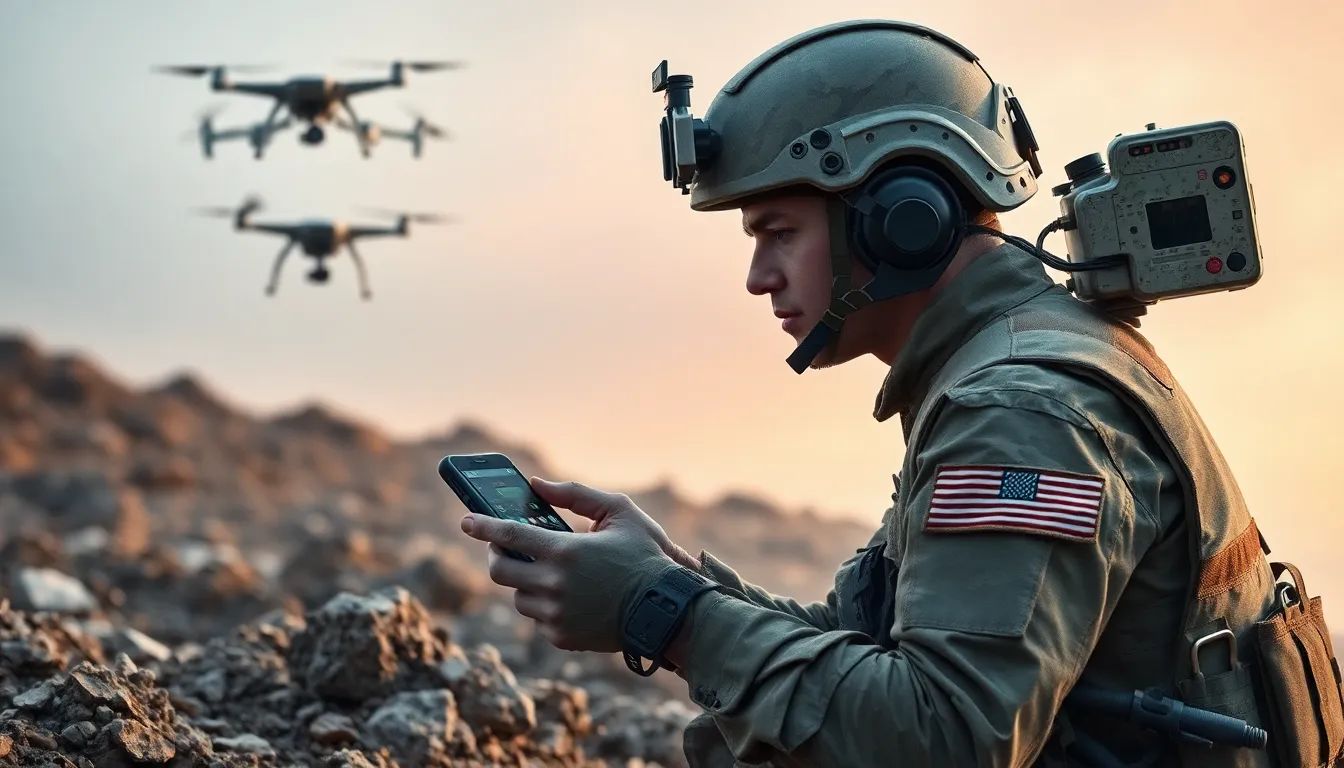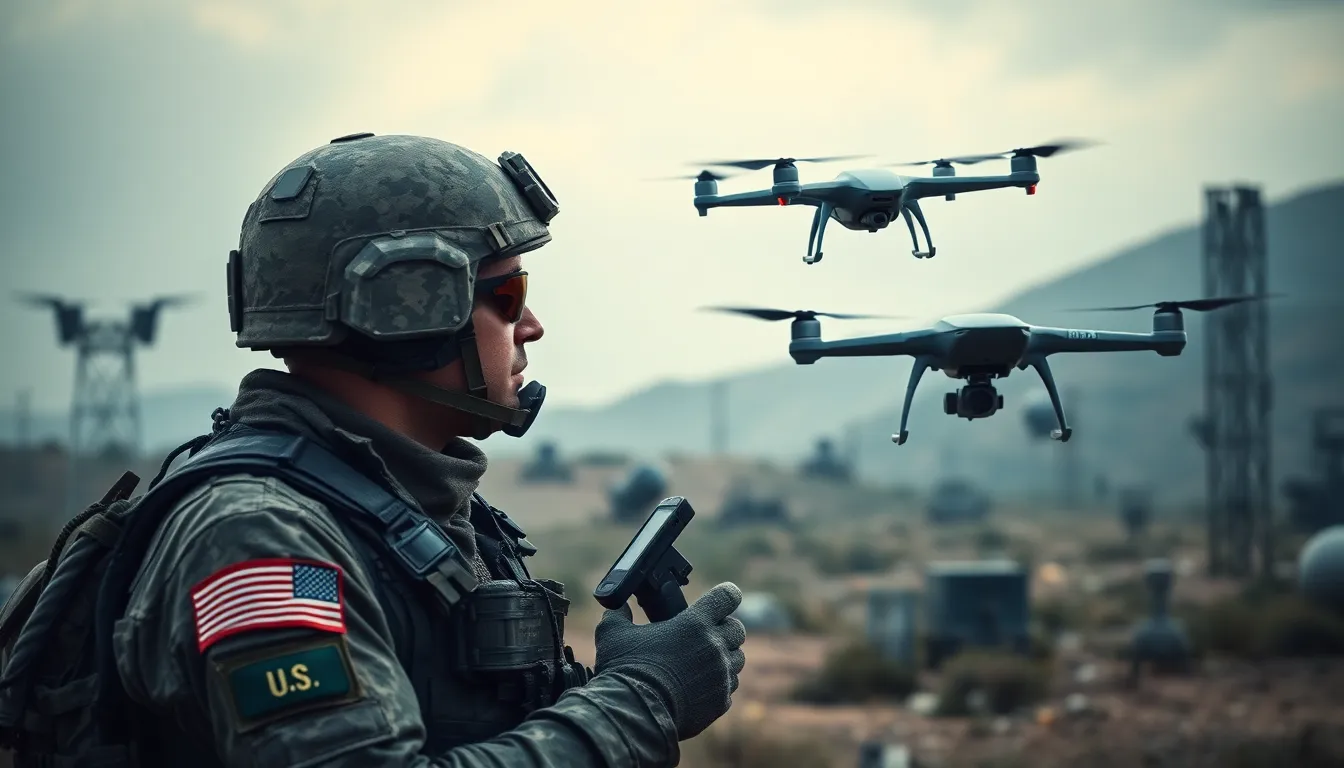The Internet of Military Things (IoMT) is transforming the battlefield into a high-tech playground where gadgets and gear communicate faster than a soldier on caffeine. Picture this: drones buzzing overhead, tanks sharing intel in real time, and soldiers equipped with smart gear that practically thinks for them. It’s not just a sci-fi dream; it’s the future of defense.
As military forces embrace this digital revolution, they’re not just upgrading their arsenal; they’re redefining strategy and tactics. The IoMT connects everything from weapon systems to logistics, creating a seamless flow of information that can mean the difference between victory and defeat. In a world where every second counts, the military’s digital transformation is not just smart—it’s essential. Get ready to dive into the fascinating world of IoMT and discover how it’s changing the game in defense technology.
Table of Contents
ToggleOverview of Internet of Military Things
The Internet of Military Things (IoMT) significantly enhances operational capabilities by integrating advanced technologies in defense settings. IoMT connects a broad range of devices, including sensors, drones, and smart wearable gadgets, all designed to improve communication and collaboration among military personnel. Real-time data collection plays a crucial role in this integration, enabling forces to make informed decisions quickly.
Enhanced situational awareness is achieved through the continuous flow of information among battlefield assets. Smart sensors monitor environments, detect threats, and provide actionable insights, which boosts the effectiveness of strategic planning. Connected devices enhance logistical operations, ensuring supplies reach troops efficiently and reducing delays in critical situations.
Military forces leverage artificial intelligence to process large amounts of data collected from these interconnected devices. This analysis reveals patterns and potential threats, empowering commanders to develop proactive strategies. Furthermore, IoMT enhances training simulations by providing realistic scenarios powered by data from real-world encounters.
Adoption of IoMT technologies influences not only equipment upgrades but also reshapes military strategies and tactics. Forces must adapt quickly to harness the full potential of these innovations while addressing cybersecurity vulnerabilities inherent in interconnected systems. Numerous defense agencies recognize the importance of implementing robust cybersecurity measures to protect sensitive information from adversaries.
Overall, the IoMT revolutionizes the landscape of modern warfare, emphasizing the integration of technology into defense operations. Continuous advancements in this field offer military forces a competitive edge, allowing them to maintain control in challenging environments. Through IoMT, the future of warfare stands poised for remarkable transformation.
Key Components of Internet of Military Things

Strategically, the Internet of Military Things integrates various critical elements that enhance military operations. Two of the most vital components include sensors and devices, as well as communication networks.
Sensors and Devices
Sensors play a pivotal role in the IoMT ecosystem. They gather real-time data from the battlefield, detecting changes in environmental conditions and identifying potential threats. Various types of sensors, including thermal imaging and motion detectors, continuously monitor surroundings. Drones serve as aerial sensors, providing reconnaissance and surveillance capabilities. These devices generate actionable intelligence, empowering commanders to make informed decisions based on accurate information.
Communication Networks
Robust communication networks ensure seamless information transfer among military assets. These networks facilitate data sharing between sensors and command centers, equipping personnel with up-to-date situational awareness. High-frequency radio and satellite communication systems form the backbone of this interconnected environment. Encryption protocols protect the integrity of transmitted data, mitigating risks associated with cyber threats. Effective communication strategies enhance collaborative efforts, streamline command functionalities, and optimize operational responsiveness in diverse combat scenarios.
Benefits of Internet of Military Things
The Internet of Military Things (IoMT) provides significant advantages to military operations, fundamentally altering how forces approach warfare.
Enhanced Situational Awareness
IoMT enhances situational awareness by providing real-time data from various sensors and devices deployed across the battlefield. Smart sensors track environmental conditions and detect potential threats, ensuring commanders receive timely information. Drones equipped with surveillance capabilities offer aerial insights, identifying enemy positions and movements. Continuous data flow allows for more responsive and strategic decision-making. As a result, military personnel can maintain a comprehensive understanding of the operational landscape, leading to more effective mission planning.
Improved Decision-Making
The interconnected nature of IoMT facilitates improved decision-making among military leaders. Artificial intelligence analyzes vast amounts of data collected from numerous devices, identifying patterns and trends visible only through comprehensive analysis. Commanders access actionable insights rapidly, enabling them to respond proactively to emerging situations. Collaboration among various military units becomes seamless, fostering a unified approach during operations. Enhanced data integrity through robust communication networks supports informed choices, ultimately increasing mission success rates.
Challenges and Concerns
Security risks pose significant challenges for the Internet of Military Things (IoMT). Cyberattacks can compromise sensitive data, leading to tactical disadvantages. In 2021, the U.S. Defense Department reported over 10,000 cybersecurity incidents involving military networks. Inadequate security protocols can enable adversaries to manipulate connected devices, jeopardizing mission success. Constant monitoring and advanced threat detection systems are crucial to mitigate these vulnerabilities.
Integration with existing systems also presents challenges. Combining legacy equipment with new IoMT technologies can create compatibility issues. For example, older communication protocols may not support real-time data sharing, limiting the effectiveness of new devices. Defense agencies must invest in infrastructure upgrades to ensure seamless interoperability. Training personnel on new technologies enhances operational effectiveness and helps bridge the gap between traditional tactics and modern capabilities.
Future Trends in Internet of Military Things
Emerging trends within the Internet of Military Things (IoMT) forecast a deeper integration of autonomous systems and artificial intelligence. Increased automation fuels drones and ground vehicles, allowing them to perform missions with minimal human oversight. This shift enhances operational efficiency, especially in high-risk scenarios.
Augmented reality technologies play a vital role in training and mission execution. Military personnel use augmented reality devices to visualize data overlays, improving situational awareness during operations. With information readily available, soldiers can make faster, informed decisions.
Predictive analytics will transform mission planning, enabling military forces to anticipate threats and allocate resources effectively. Implementing machine learning algorithms analyzes vast data sets from connected devices, identifying potential risks before they manifest. This proactive approach significantly enhances strategic planning and operational readiness.
Cybersecurity remains a critical focus area, as the IoMT ecosystem expands. Advanced encryption methods must protect sensitive information gathered from connected networks. Ensuring data integrity against evolving cyber threats requires consistent investment in security technologies.
Lastly, collaboration among allies will increase as IoMT systems become more interoperable. Standardization of protocols facilitates data sharing between military forces across nations, strengthening joint operations. Improved interoperability promotes unified efforts in addressing global security challenges.
The Internet of Military Things is reshaping the future of warfare by enhancing operational capabilities and improving situational awareness. As military forces embrace interconnected devices and advanced technologies, they gain a critical edge in strategy and execution. However, the journey is not without its challenges.
Cybersecurity remains a paramount concern as threats evolve alongside technological advancements. Ensuring robust protective measures and seamless integration of new systems with legacy equipment is essential for maximizing the potential of IoMT.
As the landscape continues to change, collaboration among allied forces will be vital in harnessing the full benefits of IoMT. The ongoing commitment to innovation and adaptation will ultimately define the success of military operations in an increasingly complex global security environment.





